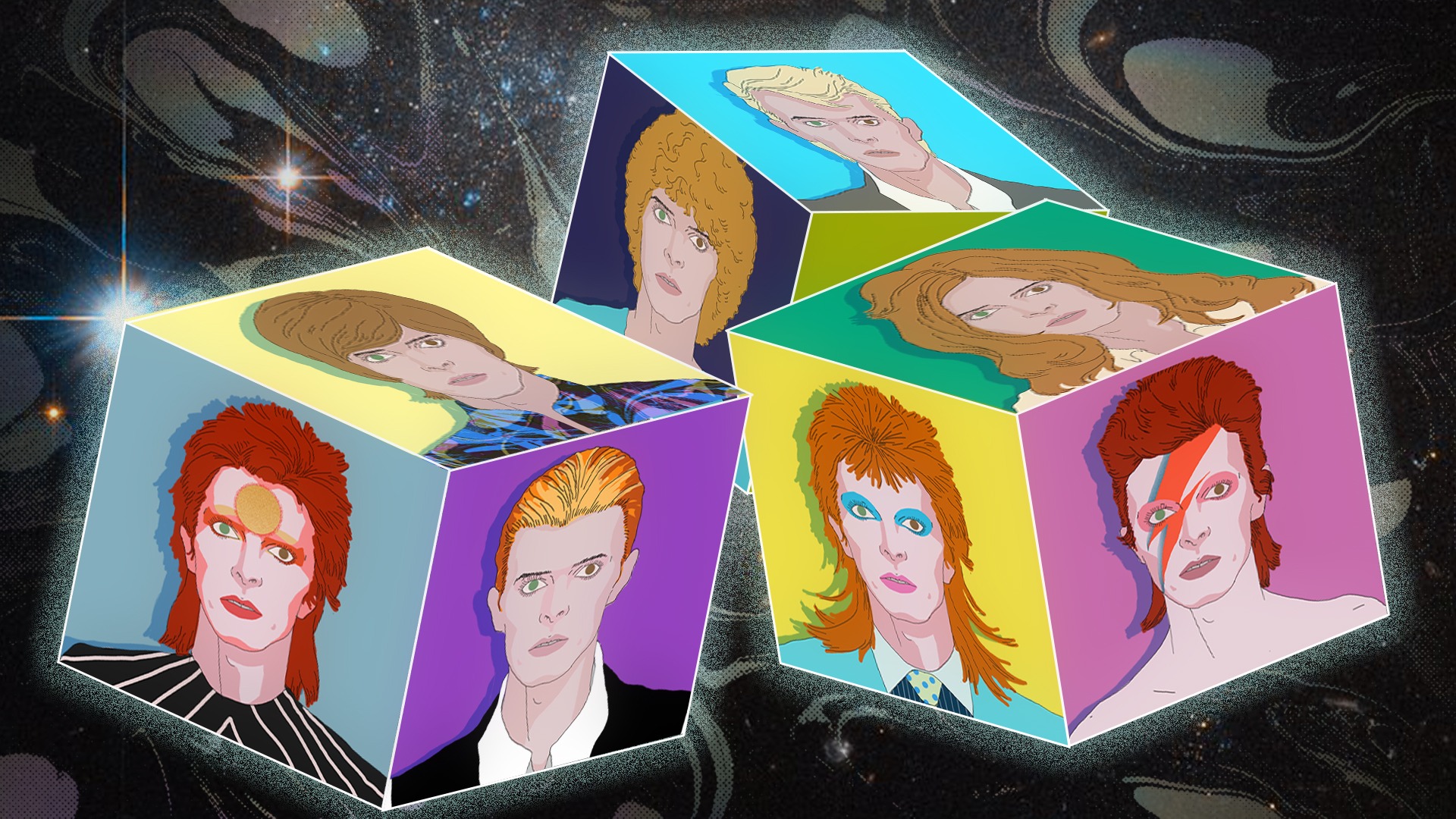“I took a look at my thoughts, my appearance, my expressions, my mannerisms, and idiosyncrasies, and didn’t like them. So I stripped myself down, chucked things out and replaced them with a completely new personality. When I heard someone say something intelligent, I used it later as if it were my own. When I saw a quality in someone that I liked, I took it. I still do that. All the time. It’s just like a car, man, replacing parts.” – David Bowie, Rolling Stone, 1976.
The multifaceted artist David Bowie famously carried this chameleon-like approach throughout the course of his career, a habit that would ensure his fate as one of the most influential musicians and performers of all time.
But has David Bowie, as some would claim, truly left a memorable mark on every musical genre? We’re taking a look at the Starman’s discography to find out.
Folk
Bowie started his musical career with a more folksy direction. His self-titled debut album, released in 1967, features the opening song “Uncle Arthur,” which has a definitive folk-inspired sound.
However, it’s Bowie’s famous “Space Oddity” (1969) that seems to have cemented his place in the books of folk music history. Despite adopting a heavy prog-rock sound, the song features a folk-style guitar, with those chords becoming some of the genre’s most emblematic arrangements.
Glam rock
Undoubtedly, Bowie’s most recognizable persona is Ziggy Stardust, created during his glam rock era that birthed the concept album The Rise and Fall of Ziggy Stardust and the Spiders From Mars (1972). The album, which tells a story of an alien rockstar come to turn people back onto the positivity of rock ‘n’ roll music, is essentially a “blueprint for fame,” with Ziggy embodying the theatrics not only of Bowie himself, but of the whole glam rock scene.
Despite Ziggy’s popularity, Bowie decided to retire the persona after only one year (from 1972 to 1973), subsequently sharing a new creation with the world that is often confused with its predecessor: Aladdin Sane.
“I didn’t want to be trapped in this Ziggy character all my life,” explained Bowie in another Rolling Stone interview. “I guess what I was doing on Aladdin Sane, I was trying to move into the next area – but using a rather pale imitation of Ziggy as a secondary device. In my mind, it was ‘Ziggy Goes to Washington: Ziggy under the influence of America.’” Exploring the artist’s disenchantment with fame’s trappings and its ephemeral nature, Aladdin Sane brought forward an overall darker tone to this next creative phase.
Although Bowie expressed a desire to distance himself from the arguably more innocent Ziggy persona, there is some definite sonic overlap between his two characters. Aladdin Sane (1973) was released while Bowie was very much still performing as the Starman, but it definitively embraced glam rock thanks to the addition of Mick Ronson’s stellar guitar skills (Ronson is often recognized as glam rock’s greatest guitarist).
Bowie’s foray into glam rock, and the elevated level of artistry he contributed to it, allowed the genre to be remembered for more than just over-the-top shows; he helped to establish glam rock’s credibility and inspired countless musicians who would follow in these theatrical footsteps (Lady Gaga anyone?).
Rock
Although Bowie may not have released any tracks that sonically absolutely meet the genre’s criteria, there is no denying that the artist’s influence can be felt throughout rock music.
Despite it featuring the acoustic guitar, Bowie’s most rock-sounding album, The Man Who Sold the World (1970), marked the artist’s evolution from folk to a more hard rock sound. Inspired by Ozzy Osbourne and Alice Cooper, and foreshadowing the Aladdin Sane trend of exploring themes of disenchantment, Bowie’s work featured darker yet theatrical lyrics and performances, which would later also serve as fodder for future artists.
As mentioned, although Bowie didn’t fully throw himself into the genre, he nevertheless made his presence felt on such albums like Iggy and The Stooges’ Raw Power (1973) and Lou Reed’s hugely influential Transformer (1972) album, both of which he produced, as well as through his collaboration with the Rolling Stones (1985).
This is not to mention all of the Bowie covers that were later performed by musicians such as grunge great Kurt Cobain or the Seattle-based rock band Green River, who released their own rendition of “Queen Bitch”.
Bowie’s past work also hints at some rock tendencies, with the aforementioned “Space Oddity” featuring undeniable prog-rock sounds. So while he may not have produced an album that is explicitly rock, there’s no question that Bowie made an impression on the genre and its artists.
Electronic
Bowie is undisputedly credited with taking what seminal bands like Kraftwerk started and bringing it to the mainstream masses. Not until Radiohead released their Kid A album in 2000 did the genre garner so much attention from the public (Radiohead, incidentally, also cite Bowie as an influence).
The artist’s Berlin Trilogy – three albums released in 1977 and 1979 that are deemed as his most electronic-sounding projects – did not go unnoticed. Maybe you’ve heard of a little song called “Heroes” that appeared in several Hollywood hits like Moulin Rouge and The Perks of Being a Wallflower, as well as in the TV show Glee, just to share a (very) brief list.
However, it’s important to note that Bowie’s Trilogy does not focus exclusively on the electronic genre. Through his work with fellow musician Brian Eno on these albums, Bowie fused electronic and rock together, yet another example of the artist’s love of blending genres. More importantly, Bowie managed to create a body of work that has been deemed as existing almost apart from time, a feat that not many electronic records can claim to have achieved.
Pop
When it comes to pop music, it’s impossible to downplay Bowie’s impact on the genre. The artist released Let’s Dance (1983), a multi-genre mashup album that would, according to his website, “become the most commercially successful album of his career, selling some 7 million copies worldwide”. The title track, also named “Let’s Dance”, became Bowie’s first and only song to hit #1 on both the UK and the US charts, and went on to define what alternative dance music would sound like for the next several decades.
Similarly, songs like “Queen Bitch”, “Andy Warhol”, and “Changes” (all from 1971’s Hunky Dory) would also leave their mark on the future sounds of lo-fi indie pop music.
No Bowie listicle would be complete without mentioning his absolute mammoth of a collaboration with Queen – a band that similarly enjoyed mashing genres together:
And did we mention that Bowie’s was the first concert a young Madonna ever attended?
Rap/Hip Hop
While it’s true that David Bowie never released a hip hop album, his presence can nevertheless be felt throughout the genre as well.
Bowie’s first foray into hip hop actually came in the form of a shoutout by George Clinton of the group Parliament in the song “P. Funk (Wants to Get Funked Up)”. But this wasn’t some arbitrary name drop for clout. Clinton (unsurprisingly) names Bowie’s flirtation with the world of funk (like in “Let’s Dance”) as a source of inspiration for one of his greatest hits, “Give Up the Funk (Tear the Roof Off the Sucker)”. That track proved to be incredibly significant for the band, as it appeared in movies, TV shows, and commercials, and was otherwise hugely impactful on rap – a testament to just how wide-ranging Bowie’s musical influence was.
But it wasn’t just thanks to Parliament that Bowie was able to reach a different audience. Sampling, one of today’s most hotly debated topics in the industry, was actually the vehicle through which a whole new audience was introduced to the performer.
For starters, “Fame” from Bowie’s album Young Americans (1975), has been sampled by a multitude of artists, from Ol’ Dirty Bastard (“Dirty Run”) to Dr. Dre (“Fame”) to Jay-Z (“Takeover”).
Bowie’s production chops were also honoured through rap, when A Tribe Called Quest sampled Lou Reed’s Bowie-produced track “Walk on the Wild Side” in their song “Can I Kick It”.
Interestingly, Vanilla Ice’s single “Ice Ice Baby” is one of the most recognizable instances of Bowie’s work being sampled, yet the rapper went on record to vehemently deny outright sampling “Under Pressure” (he has since acknowledged sampling the song).
To list all of the artists and producers who’ve sampled Bowie would be an impressive task, but suffice it to say that the hip hop world embraced the artist just as readily as did its other musical contemporaries.
–Final Notes–
No matter how you look at it, David Bowie has definitely impacted music as a whole. Countless musicians and industry professionals have named at least one Bowie single that shaped who they are as creators. “Bowie is so often cited as an influence by people, but that’s almost like saying that food is an influence,” wrote genre-mashing musician St. Vincent for NME in 2013. Regardless of whether you’re a fan or not, Bowie’s fearless approach to both his performances and artistic expression in general – as well as his unshakeable faith in his vision and talent – made room for unapologetic self-expression and offered something that any artist could interpret in their own fashion.
As Bowie once said, “all my big mistakes are when I try to second-guess or please an audience. My work is always stronger when I get very selfish about it”, an attitude that served the artist well over his near half-century in the music industry.
Written by Ania Szneps
Illustration by Yihong Guo



















